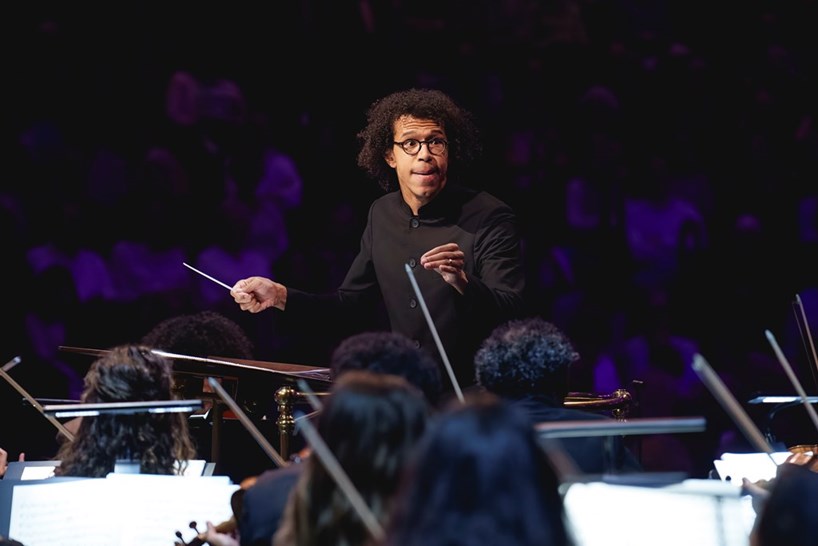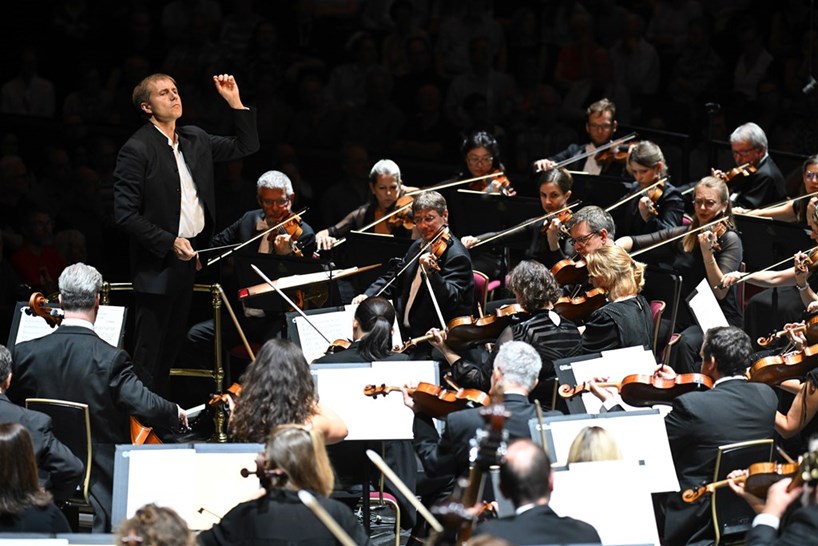ONE of the many anniversaries marked by the BBC in this year’s Henry Wood Promenade Concerts was that of the death of Shostakovich in 1975; another was the sesquicentenary of the birth of Ravel.
The composers were paired, incongruously, in a concert on 15 August, which I heard on BBC Sounds. The latter’s Piano Concerto in G major was given a scintillating performance by Benjamin Grosvenor.
Shostakovich’s Symphony No. 13, Babi Yar, a setting of poems by Yevtushenko, is a dark piece. Babi Yar was the ravine just outside Kyiv where nearly 34,000 Jews were murdered by the Nazis in 1941. With the work’s implied criticism of anti-Semitism in the Soviet Union, it was something of a miracle that the first performance in 1962 actually took place. Its continuing relevance hardly needs underlining. The bass Alexander Vinogradov, the BBC National Orchestra of Wales, and the men’s voices of the BBC National Chorus of Wales and the Welsh National Opera Chorus (chorus-master Adrian Partington), conducted by Ryan Bancroft, sounded magnificent.
The next day, it was the turn of Shostakovich’s Fifth Symphony of 1938, played from memory by the Aurora Orchestra under Nicholas Collon. Two years ago, I raved over their “dramatic exploration” of Stravinsky’s The Rite of Spring: a spoken introduction by two actors and the conductor, with illustrations by the orchestra, in the first half, followed after the interval by a complete performance (Arts, 15 September 2023). The format was equally successful last year with Beethoven’s Ninth.
The Shostakovich was too tricksy by half, however. The feat of memory was as impressive as ever, especially in the illustrations. But, instead of an analysis with, say, excerpts from letters and diaries, we had a trio of Soviet censors discussing and interrogating, and a silent “actor/dancer” representing the composer, writhing and twitching when not being borne shoulder high. It was shown on BBC4 on 17 August. After performances at the Proms in 2013, 2018, 2019, and 2024, the symphony is surely due for a rest.
The Tenth was Shostakovich’s first symphony after a gap of eight years. It had its première in 1953, significantly after the death of Stalin, and it is one of the composer’s most personal works. His musical motto, depicting four of the initials of his name, alternates and is eventually combined with a five-note motto beginning with E and A. This is heard rather too often; it was revealed in 1994 to have stood for Elmira Nazirova, one of the composer’s pupils.
 BBC Andy ParadiseJonathon Heywood conducts the Chineke! Orchestra in Shostakovich. He stepped in to replace Sir Simon Rattle
BBC Andy ParadiseJonathon Heywood conducts the Chineke! Orchestra in Shostakovich. He stepped in to replace Sir Simon Rattle
Each iteration was flawlessly played by Pierre Buizer, the first horn of the Chineke! Orchestra, which appeared on 5 September. Jonathon Heyward, stepping in at short notice for Simon Rattle, conducted a superb performance: the fleetness of the strings, the dark tone of the violas at the outset, and the sensitive phrasing of the clarinet and flute were only a few of the many admirable features. The first half included The Bamboula, a ten-minute “rhapsodic dance” by Samuel Coleridge-Taylor (b. 1875), vividly played. The concert was transmitted on BBC4 on 7 September.
There is a four-note motif in Shostakovich’s Cello Concerto No. 1, too. If rearranged, the notes resemble his personal motto: they certainly appear often enough to suggest an association of some kind. At the concert on 10 September, Anastasia Kubekina started well with her spiky delivery; later on, she was sometimes obscured by the orchestra, coming into her own only in the cadenza that comprises the third movement. The piece is almost a double concerto for cello and horn: Chris Gough was splendidly prominent. The BBC Scottish Symphony Orchestra (BBCSSO) sounded well under Delyana Lazarova, the hushed strings at the opening of the second movement being particularly memorable.
The BBCSSO appeared the following day under its former principal conductor Ilan Volkov, beginning with a fine transcription by Bruno Maderna of the motet In ecclesiis by Giovanni Gabrieli and ending with a heart-warming account of Brahms’s Second Symphony. The National Youth Choir (chorus-master Nicholas Chalmers) joined the orchestra for Stravinsky’s last major work, the 15-minute Requiem Canticles, in a brilliant performance that included chanting that harked back to the Libera Me of the Requiem by Verdi.
I heard three concerts that included works by English composers; or I should say part-English, as Gipps had a Swiss mother, Bliss an American father, and we all know about Handel. . . Ruth Gipps (1921-99), a doughty advocate of traditional forms and styles of music, is having something of a moment, at least on disc. Her Death on the Pale Horse, an orchestral piece after William Blake composed in 1943, was surprisingly lush in places, with prominent writing for the woodwind.
After Grieg’s Piano Concerto, seemingly effortlessly played by 24-year-old Lukas Sternath, came Arthur Bliss’s cantata The Beatitudes. Commissioned for the opening of Coventry’s new cathedral in 1962, but unsatisfactorily performed in the city’s Belgrade Theatre, it was pretty well blown out of the water by a more famous commission, Britten’s War Requiem.
There is some effective writing for semi-chorus (the BBC Singers), and there are soaring phrases for the soprano and tenor (Elizabeth Watts and Laurence Kilsby) and rather too much homophonic writing for the chorus (the BBC Symphony Chorus, chorus-master Neil Ferris). It was perhaps unwise of Bliss to choose three of the poems by George Herbert which Vaughan Williams had set in his Five Mystical Songs. The pealing “Amens” set the seal on a sterling performance by Sakari Oramo and the BBC Symphony Orchestra.
 chris ChristodoulouVaughan Williams, A London Symphony
chris ChristodoulouVaughan Williams, A London Symphony
On the morning of the same day, 7 September, it was a different work by Vaughan Williams which filled the second half of the concert. First came Respighi’s Pines of Rome, exuberantly played, the Albert Hall organ cutting through at the end. It was followed by Darius Milhaud’s own arrangement for violin and orchestra of his ballet Le boeuf sur le toit. The catchy refrain had the Royal Philharmonic Orchestra under Vasily Petrenko swinging with the best. Arabella Steinbacher dazzled in the solo cadenza (composed by Arthur Honegger), and again in her encore, the Dies Irae movement of Ysaÿe’s Second Violin Sonata.
The VW was the London Symphony, played last year in its original, longer version. By a strange coincidence, the rising fourth for the horn in the slow movement, repeated several times, is an exact echo — or, rather, anticipation — of Shostakovich’s Elmira motif: same notes, same instrument. The movement is topped and (almost) tailed by a solo for cor anglais, beautifully phrased by Patrick Flanaghan. The whole performance was strikingly atmospheric.
But the “English” concert that I enjoyed most was Handel’s Alexander’s Feast, given on 30 August by the Irish Baroque Chorus and Orchestra, in the version performed in Dublin in 1742. With the exception of two places where he speeded up unnecessarily, Peter Whelan conducted with impeccable style, singers and players responding to his infectious enthusiasm.
The tenor Stuart Jackson showed prodigious breath control in the roulades of “Happy, happy, happy pair!”. The soprano Hilary Cronin also sounded a born Handelian, nowhere better than in the (inappropriately) graceful “Thais led the way, To light him to his prey”; and the counter-tenor Hugh Cutting movingly described the death of Darius. The main surprise was the bass aria “Revenge, revenge! Timotheus cries”, rewritten for tenor followed by alto, with no repeat of the first section. An added delight was the inclusion of movements from two of the Concerti a due core, Handel’s self-borrowings including “Lift up your heads” from Messiah.
A passing mention of an evening of French music with the BBCSO under Marie Jacquot on 28 August. It ended with Saint-Saëns’s “Organ” Symphony, a piece I find it hard to take seriously; but Rachel Mahon wowed the audience with her fortissimo entry in the Finale.
More visitors from abroad included the Leipzig Gewandhaus Orchestra on 26 August, under its music director, Andris Nelsons. There was some fine horn-playing in the Adagio of Dvorák’s Violin Concerto, and, again at the end, a solo horn duetting with the excellent Isabelle Faust, who was standing in for Hilary Hahn. In Sibelius’s Second Symphony, the rubato of the cor anglais player in the third movement was particularly sensitive.
The last week of the Proms brought two concerts by the Vienna Philharmonic Orchestra. The second one, on 9 September, consisted of symphonies by Mozart and Tchaikovsky. Full marks to Franz Welser-Möst for playing all the repeats in the Prague, including the second one in the last movement; but it was a pity that the first and second violins were not separated, thus vitiating their antiphonal exchanges.
In the Pathétique, Welser-Möst cunningly forestalled premature applause by moving immediately from the third movement’s march into the final Adagio lamentoso. It was a treat to hear these wonderful players in repertoire that one does not normally associate with them. And, as ever, a bouquet to the hard-working musicians of the BBC Symphony Orchestra, who brought the season to an end on 13 September with their usual panache.
All the Proms can be heard on BBC Sounds for 4 weeks; those that were televised can be watched on BBC iPlayer till mid-2026.















